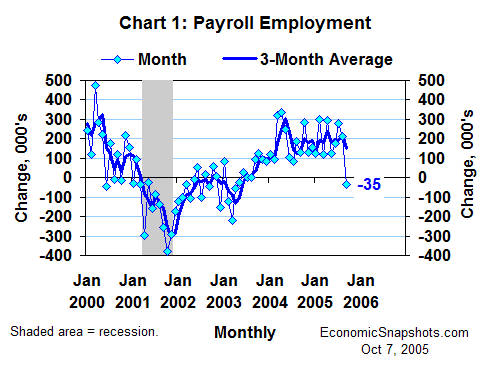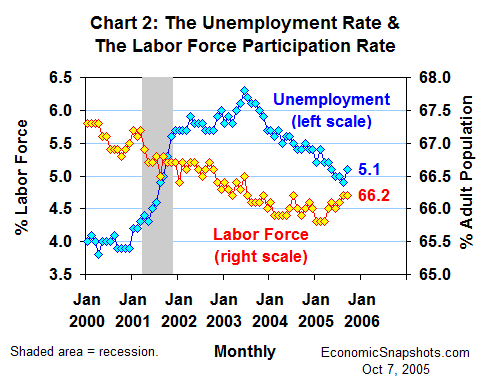
| Back to Index |
October 7, 2005 – U.S. payroll employment edged down by 35K in September (Chart 1) – essentially unchanged after a revised 211K August gain (originally +169K). Revisions added 77K to payroll growth for the prior two months.

These data were stronger than expected. The devastation wrought by Hurricane Katrina had been widely expected to cause a much larger September payroll decline.
Payroll growth averaged 194K per month for the year through August. The BLS said that, outside of the hurricane disaster areas, September payroll growth fell in line with this pre-Katrina trend. Thus, a reasonable rough guess at the impact of Hurricane Katrina on September payrolls is a reduction of about 230K. (That’s the total deviation in September payroll growth from its pre-Katrina trend: –35K – 194K = –229K, or about –230K.)
Many of these hurricane-related job losses should prove to be temporary, although the timing is uncertain. We should see these jobs coming back as the hurricane-afflicted areas become more settled, and more establishments reopen their doors. In addition, the massive rebuilding effort that still lies ahead is likely to generate a burst of new jobs in these areas.
The unemployment rate rose by 0.2 percentage points to 5.1% in September, while the labor force participation rate was unchanged at 66.2% (Chart 2).

According to the household survey, the labor force rose by 252K in September. Consistent with the payroll survey, September employment was essentially unchanged, edging down by 17K. September unemployment rose by 270K.
Bottom line: These data suggest that virtually all of the weakness in September employment growth was caused by Hurricane Katrina – in other words, a temporary setback. They do not support the case for a broader economic slowdown.
Suzanne Rizzo